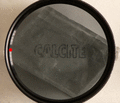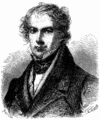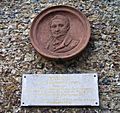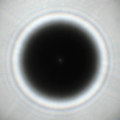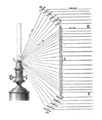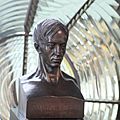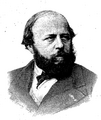Augustin-Jean Fresnel facts for kids
Quick facts for kids
Augustin-Jean Fresnel
|
|
|---|---|
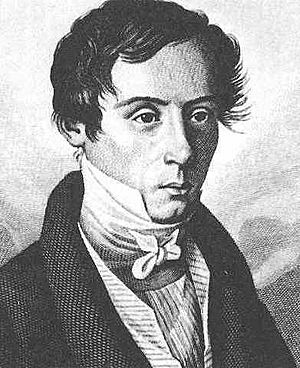
Portrait of "Augustin Fresnel"
from the frontispiece of his collected works (1866). |
|
| Born | 10 May 1788 Broglie, Kingdom of France (now Eure, France)
|
| Died | 14 July 1827 (aged 39) |
| Cause of death | Tuberculosis |
| Resting place | Père Lachaise Cemetery |
| Nationality | French |
| Education |
|
| Known for |
|
| Awards |
|
| Scientific career | |
| Fields | Physics, Engineering |
| Institutions |
|
| Influences | |
| Influenced |
|
Augustin-Jean Fresnel (born May 10, 1788 – died July 14, 1827) was a French civil engineer and physicist. He is famous for his work in optics, which helped scientists finally agree that light travels as a wave. Fresnel studied light both in theory and through experiments.
He is probably best known for inventing the Fresnel lens. This special lens was first used in lighthouses when he worked as a French commissioner for lighthouses. Today, Fresnel lenses are used in many different ways. His equations about waves and how light reflects are also important for things like computer graphics. For example, they help make realistic images of water in video games and movies.
Contents
About Augustin Fresnel's Life
Early Life and Education
Augustin Fresnel was born in Broglie, France. His father was an architect. When he was young, Augustin learned slowly and couldn't read until he was eight years old.
At age thirteen, he joined the École Centrale in Caen. Then, at sixteen and a half, he went to the École Polytechnique, a very good school where he did very well. After that, he continued his studies at the École des Ponts et Chaussées.
Working as an Engineer
Fresnel worked as an engineer in different parts of France. In 1814, he supported the Bourbon royal family. When Napoleon returned to power in 1815, Fresnel lost his job.
However, when the monarchy was restored again in 1815, he got a job as an engineer in Paris. He lived and worked there for most of his life.
Discoveries and Recognition
Fresnel started his research into light around 1814. In 1818, he wrote an important paper about diffraction (how light bends around corners). For this work, he won a prize from the French Academy of Sciences the next year.
He was the first person to create a special lens, now called a Fresnel lens, to replace heavy mirrors in lighthouses. In 1819, he became a commissioner for lighthouses, which helped him put his invention to use.
In 1823, he was chosen to be a member of the French Academy of Sciences. In 1825, he also became a member of the Royal Society of London. Sadly, he became very ill in 1827. The Royal Society of London gave him the Rumford Medal that year, just before he passed away.
His Final Years
Augustin Fresnel died from tuberculosis near Paris. He didn't get much public fame for his work in optics during his lifetime. Some of his papers were even printed many years after he died.
But Fresnel didn't care much about fame. He once wrote to another scientist, Thomas Young, that finding a new scientific truth or seeing an experiment prove his calculations made him happier than any praise.
His name is one of the 72 names written on the Eiffel Tower in Paris, honoring his contributions.
Fresnel's Amazing Discoveries in Light
Understanding Light as a Wave
Fresnel's discoveries and math, building on experiments by Thomas Young, greatly expanded the wave theory of light. This theory explains how light behaves like waves.
In 1817, Young thought light waves had a small side-to-side movement. But by 1821, Fresnel showed that polarization (how light waves vibrate in a specific direction) could only happen if light waves moved entirely side-to-side, with no up-and-down movement at all.
Experiments with Light
Fresnel used two flat metal mirrors placed at a very wide angle (almost 180 degrees). This helped him avoid problems with diffraction (light bending) that happened in earlier experiments. This way, he could clearly show how light waves interfere with each other, supporting the wave theory.
With another scientist, François Arago, he studied how polarized light waves interfere. He also created a special glass shape called a Fresnel rhomb. This rhomb could produce a type of light called circularly polarized light.
One of his most important written works was his "Memoir on the Diffraction of Light," which he submitted to the Academy of Sciences in 1812.
Fresnel's Lasting Impact
Fresnel's achievements are even more amazing because he battled tuberculosis his whole life. He died at the young age of 39. Even though he wasn't a public celebrity, he did receive important awards from other scientists, like the Rumford Medal from the Royal Society of London, just before he died.
Today, Fresnel's name is used everywhere in the study of optics and waves. His ideas and inventions continue to be very important in science and technology.
Images for kids
-
Monument to Augustin Fresnel on the facade of his birthplace at 2 Rue Augustin Fresnel, Broglie (facing Rue Jean François Mérimée), inaugurated on 14 September 1884. The inscription, when translated, says: "Augustin Fresnel, engineer of Bridges and Roads, member of the Academy of Sciences, creator of lenticular lighthouses, was born in this house on 10 May 1788. The theory of light owes to this emulator of Newton the highest concepts and the most useful applications."
-
Bas-relief of Fresnel's uncle Léonor Mérimée (1757–1836), on the same wall as the Fresnel monument in Broglie
-
A right-handed/clockwise circularly polarized wave as defined from the point of view of the source. It would be considered left-handed/anti-clockwise circularly polarized if defined from the point of view of the receiver. If the rotating vector is resolved into horizontal and vertical components (not shown), these are a quarter-cycle out of phase with each other.
-
Chromatic polarization in a plastic protractor, caused by stress-induced birefringence.
-
First-order rotating catadioptric Fresnel lens, dated 1870, displayed at the Musée national de la Marine, Paris. In this case the dioptric prisms (inside the bronze rings) and catadioptric prisms (outside) are arranged to give a purely flashing light with four flashes per rotation. The assembly stands 2.54 metres tall and weighs about 1.5 tonnes.
-
Bust of Augustin Fresnel by David d'Angers (1854), formerly at the lighthouse of Hourtin, Gironde, and now exhibited at the Musée national de la Marine
See also
 In Spanish: Augustin Fresnel para niños
In Spanish: Augustin Fresnel para niños







